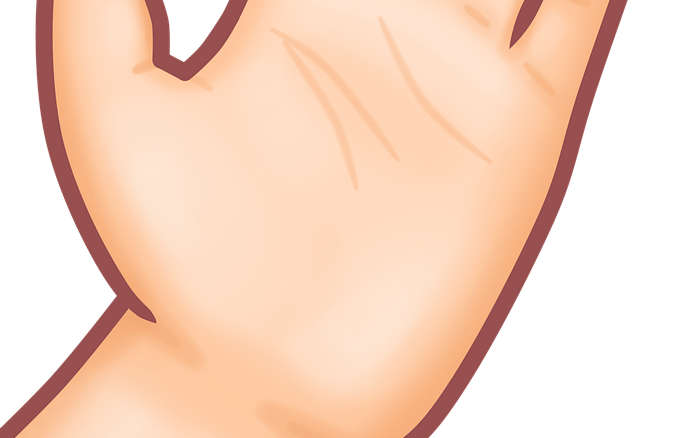Carpal Tunnel Syndrome
What is Carpal Tunnel Syndrome?
Carpal tunnel syndrome is a common condition that causes pain, numbness, and tingling in the hand and arm. The condition occurs when one of the major nerves to the hand — the median nerve — is squeezed or compressed as it travels through the wrist.
In most patients, carpal tunnel syndrome gets worse over time, so early diagnosis and treatment are important. Early on, symptoms can often be relieved with simple measures like wearing a wrist splint or avoiding certain activities.
If pressure on the median nerve continues, however, it can lead to nerve damage and worsening symptoms. To prevent permanent damage, surgery to take pressure off the median nerve may be recommended for some patients.
The carpal tunnel is a narrow passageway in the wrist, about an inch wide. The floor and sides of the tunnel are formed by small wrist bones called carpal bones.
The roof of the tunnel is a strong band of connective tissue called the transverse carpal ligament. Because these boundaries are very rigid, the carpal tunnel has little capacity to “stretch” or increase in size.
The median nerve is one of the main nerves in the hand. It originates as a group of nerve roots in the neck. These roots come together to form a single nerve in the arm. The median nerve goes down the arm and forearm, passes through the carpal tunnel at the wrist, and goes into the hand. The nerve provides feeling in the thumb and index, middle, and ring fingers. The nerve also controls the muscles around the base of the thumb.
The nine tendons that bend the fingers and thumb also travel through the carpal tunnel. These tendons are called flexor tendons.
Download our Therapeutic Exercise Program for Carpal Tunnel Syndrome
What are the causes of Carpal tunnel syndrome?
Carpal tunnel syndrome occurs when the tunnel becomes narrowed or when tissues surrounding the flexor tendons swell, putting pressure on the median nerve. These tissues are called the synovium. Normally, the synovium lubricates the tendons, making it easier to move your fingers.
Most cases of carpal tunnel syndrome are caused by a combination of factors. Studies show that women and older people are more likely to develop the condition.
Other risk factors for carpal tunnel syndrome include:
- Heredity. This is likely an important factor. The carpal tunnel may be smaller in some people or there may be anatomic differences that change the amount of space for the nerve—and these traits can run in families.
- Repetitive hand use. Repeating the same hand and wrist motions or activities over a prolonged period of time may aggravate the tendons in the wrist, causing swelling that puts pressure on the nerve.
- Hand and wrist position. Doing activities that involve extreme flexion or extension of the hand and wrist for a prolonged period of time can increase pressure on the nerve.
- Pregnancy. Hormonal changes during pregnancy can cause swelling.
- Health conditions. Diabetes, rheumatoid arthritis, and thyroid gland imbalance are conditions that are associated with carpal tunnel syndrome.
What are the symptoms and examination findings?
This exercise program for carpal tunnel syndrome should be continued for 3 to 4 weeks, unless otherwise specified by Prof Imam. After your recovery, these exercises can be continued as a maintenance program.
Symptoms of carpal tunnel syndrome may include:
- Numbness, tingling, burning, and pain—primarily in the thumb and index, middle, and ring fingers
- Occasional shock-like sensations that radiate to the thumb and index, middle, and ring fingers
- Pain or tingling that may travel up the forearm toward the shoulder
- Weakness and clumsiness in the hand—this may make it difficult to perform fine movements such as buttoning your clothes
- Dropping things—due to weakness, numbness, or a loss of proprioception (awareness of where your hand is in space)
In most cases, the symptoms of carpal tunnel syndrome begin gradually—without a specific injury. Many patients find that their symptoms come and go at first. However, as the condition worsens, symptoms may occur more frequently or may persist for longer periods of time.
Night-time symptoms are very common. Because many people sleep with their wrists bent, symptoms may awaken you from sleep. During the day, symptoms often occur when holding something for a prolonged period of time with the wrist bent forward or backward, such as when using a phone, driving, or reading a book.
Many patients find that moving or shaking their hands helps relieve their symptoms.
EXAMINATION
During your evaluation, Prof Imam will talk to you about your general health and medical history and will ask about your symptoms.
He will carefully examine your hand and wrist and perform a number of physical tests. During these tests, Prof Imam or a member of the team will:
- Press down or tap along the median nerve at inside of your wrist to see if it causes any numbness or tingling in your fingers (Tinel sign)
- Bend and hold your wrists in a flexed position to test for numbness or tingling in your hands
- Test sensitivity in your fingertips and hands by lightly touching them with a special instrument when your eyes are closed.
- Check for weakness in the muscles around the base of your thumb
- Look for atrophy in the muscles around the base of your thumb. In severe cases, these muscles may become visibly smaller.
Tests
Electrophysiological tests. These tests will help us measure how well your median nerve is working and help determine whether there is too much pressure on the nerve. The tests will also help Prof Imam determine whether you have another nerve condition, such as neuropathy, or other sites of nerve compression that might be contributing to your symptoms.
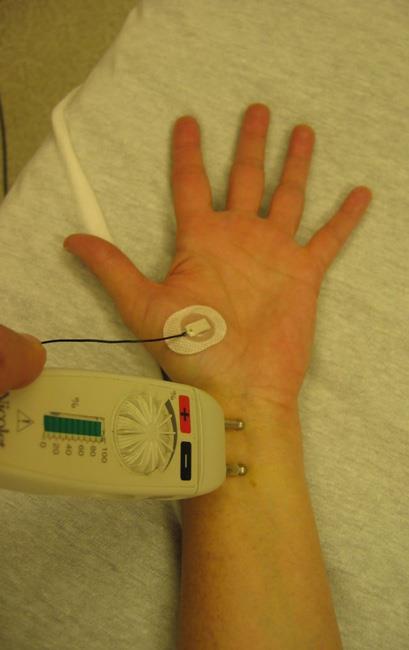
Close up of an EMG being performed with a nerve conduction study.
Electrophysiological tests may include:
- Nerve conduction studies. These tests measure the signals travelling in the nerves of your hand and arm and can detect when a nerve is not conducting its signal effectively. Nerve conduction studies can help Prof Imam determine how severe your problem is and help to guide treatment
- Electromyogram (EMG). An EMG measures the electrical activity in muscles. EMG results can show whether you have any nerve or muscle damage.
Ultrasound. An ultrasound uses high-frequency sound waves to help create pictures of bone and tissue. Prof Imam may recommend an ultrasound of your wrist to evaluate the median nerve for signs of compression.
X-rays. X-rays provide images of dense structures, such as bone. If you have limited wrist motion or wrist pain, Prof Imam may order x-rays to exclude other causes for your symptoms, such as arthritis, ligament injury, or a fracture.
Magnetic resonance imaging (MRI) scans. These studies provide better images of the body’s soft tissues. Prof Imam may order an MRI to help determine other causes for your symptoms or to look for abnormal tissues that could be impacting the median nerve. An MRI can also help Prof Imam determine if there are problems with the nerve itself—such as scarring from an injury or tumor.
Nonsurgical Treatment
If diagnosed and treated early, the symptoms of carpal tunnel syndrome can often be relieved without surgery. If your diagnosis is uncertain or if your symptoms are mild, Prof Imam will recommend nonsurgical treatment first.
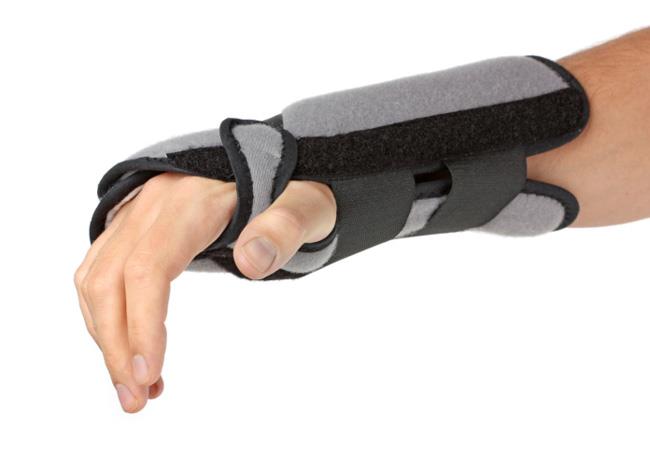
Bracing or splinting. Wearing a brace or splint at night will keep you from bending your wrist while you sleep. Keeping your wrist in a straight or neutral position reduces pressure on the nerve in the carpal tunnel. It may also help to wear a splint during the day when doing activities that aggravate your symptoms.
Nonsteroidal anti-inflammatory drugs (NSAIDs).Medications such as ibuprofen and naproxen can help relieve pain and inflammation.
Activity changes. Symptoms often occur when your hand and wrist are in the same position for too long—particularly when your wrist is flexed or extended.
If your job or recreational activities aggravate your symptoms, changing or modifying these activities can help slow or stop progression of the disease. In some cases, this may involve making changes to your work site or work station.
Nerve gliding exercises. Some patients may benefit from exercises that help the median nerve move more freely within the confines of the carpal tunnel. Specific exercises may be recommended by Prof Imam or a member of the team.
Steroid injections. Corticosteroid, or cortisone, is a powerful anti-inflammatory agent that can be injected into the carpal tunnel. Although these injections often relieve painful symptoms or help to calm a flare up of symptoms, their effect is sometimes only temporary. A cortisone injection may also be used by Prof Imam to help diagnose your carpal tunnel syndrome.
Surgical Treatment
If nonsurgical treatment does not relieve your symptoms after a period of time, your doctor may recommend surgery.
The decision whether to have surgery is based on the severity of your symptoms—how much pain and numbness you are having in your hand. In long-standing cases with constant numbness and wasting of your thumb muscles, surgery may be recommended to prevent irreversible damage.
Surgical Procedure
The surgical procedure performed for carpal tunnel syndrome is called a “carpal tunnel release.” There are two different surgical techniques for doing this, but the goal of both is to relieve pressure on your median nerve by cutting the ligament that forms the roof of the tunnel. This increases the size of the tunnel and decreases pressure on the median nerve.
In most cases, carpal tunnel surgery is done on an outpatient basis. The surgery can be done under general anesthesia, which puts you to sleep, or under local anesthesia, which numbs just your hand and arm. In some cases, you will also be given a light sedative through an intravenous (IV) line inserted into a vein in your arm.
Open carpal tunnel release. In open surgery, Prof Imam makes a small incision in the palm of your hand and views the inside of your hand and wrist through this incision. During the procedure, Prof Imam will divide the transverse carpal ligament (the roof of the carpal tunnel). This increases the size of the tunnel and decreases pressure on the median nerve.
After surgery, the ligament may gradually grow back together—but there will be more space in the carpal tunnel and pressure on the median nerve will be relieved.
Recovery
Immediately following surgery, you will be encouraged to elevate your hand above your heart and move your fingers to reduce swelling and prevent stiffness.
You should expect some pain, swelling, and stiffness after your procedure. Minor soreness in your palm may last for several weeks to several months.
Grip and pinch strength usually return by about 2 to 3 months after surgery. If the condition of your median nerve was poor before surgery, however, grip and pinch strength may not improve for about 6 to 12 months.
You may have to wear a splint or wrist brace for several weeks. You will, however, be allowed to use your hand for light activities, taking care to avoid significant discomfort. Driving, self-care activities, and light lifting and gripping may be permitted soon after surgery.
Prof Imam will talk with you about when you will be able to return to work and whether you will have any restrictions on your work activities.
Complications
Although complications are possible with any surgery, Prof Imam will take steps to minimize the risks. The most common complications of carpal tunnel release surgery include:
- Bleeding
- Infection
- Nerve aggravation or injury
Outcomes
For most patients, surgery will improve the symptoms of carpal tunnel syndrome. Recovery, however, may be gradual and complete recovery may take up to a year.
If you have significant pain and weakness for more than 2 months, Prof Imam may refer you to a hand therapist who can help you maximize your recovery.
If you have another condition that causes pain or stiffness in your hand or wrist, such as arthritis or tendonitis, it may slow your overall recovery. In long-standing cases of carpal tunnel syndrome with severe loss of feeling and/or muscle wasting around the base of the thumb, recovery will also be slower. For these patients, a complete recovery may not be possible.
Occasionally, carpal tunnel syndrome can recur, although this is rare. If this happens, you may need additional treatment or surgery.
To assist doctors in the management of carpal tunnel syndrome, the American Academy of Orthopaedic Surgeons has conducted research to provide some useful guidelines. These are recommendations only and may not apply to every case. For more information: Carpal Tunnel Syndrome – Clinical Practice Guideline (CPG) | American Academy of Orthopaedic Surgeons (aaos.org)
Do not ignore pain
You should not feel significant pain during an exercise. If numbness steadily worsens, if the ex-ercises increase the pain, or if the pain does not improve after you have performed the exercises for 3 to 4 weeks, call your doctor or physiotherapist.
Ask questions
If you are not sure how to do an exercise, or how often to do it, contact us on [email protected].uk
Exercise Program for Carpal Tunnel Syndrome
STRETCHING EXERCISES
1. Wrist Extension Stretch
Equipment Needed: None
Additional Instructions: This stretch should be done throughout the day, especially before activity. After recovery, this stretch should be included as part of a warm-up to activities that involve gripping.
• Reps: 4x a day.
• Days per week: 5 to 7.
Step-by-step directions
• Straighten your arm and bend your wrist back as if signaling someone to “stop.”
• Use your opposite hand to apply gentle pressure across the palm and pull it toward you until you feel a stretch on the inside of your forearm.
• Hold the stretch for 15 seconds.
• Repeat 5 times, then perform this stretch on the other arm.
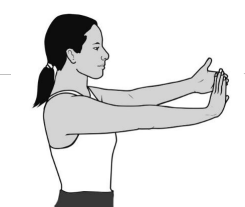
2. Wrist Flexion Stretch
Equipment needed: None
Additional instructions: This stretch should be done throughout the day, especially before activity. After recovery, this stretch should be included as part of a warm-up to activities that involve grip-ping.
• Reps: 4x a day.
• Days per week: 5 to 7.
Step-by-step directions
• Straighten your arm with your palm facing down and bend your wrist so that your fingers point down.
• Gently pull your hand toward your body until you feel a stretch on the outside of your forearm.
• Hold the stretch for 15 seconds.
• Repeat 5 times, then perform this stretch on the other arm.
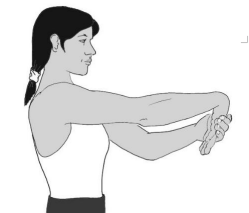
3. Medial Nerve Glides
Equipment needed: None
Additional instructions: Apply heat to your hand for 15 minutes before performing these exercises. After completing the exercises, apply a bag of crushed ice or frozen peas to your hand for 20 min-utes to prevent inflammation. Hold each position below for 3 to 7 seconds.
• Reps: 10 to 15 reps.
• Days per week: 6 to 7.
Step-by-step directions
• Make a fist with your thumb outside your fingers (1)
• Extend your fingers while keeping your thumb close to the side of your hand (2)
• Keep your fingers straight and extend your wrist (bend your hand backward toward your forearm) (3)
• Keep your fingers and wrist in position and extend your thumb (4)
• Keep your fingers, wrist, and thumb extended and turn your forearm palm up (5)
• Keep your fingers, wrist, and thumb extended and use your other hand to gently stretch the thumb (6)
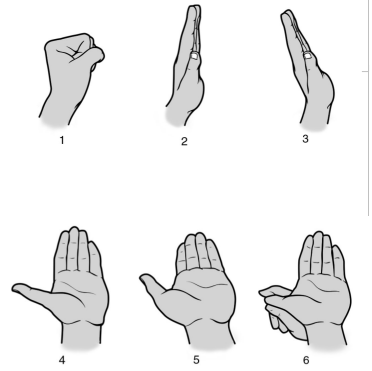
4. Tendon Glides
Equipment needed: None
Additional instructions: Apply heat to your hand for 15 minutes before performing these exercises. After completing the exercises, apply a bag of crushed ice or frozen peas to your hand for 20 minutes to prevent inflammation.
Two series of tendon gliding exercises are provided here. Follow these general instructions for both series:
• Proceed from position 1 through 3 in sequence
• Hold each position for 3 seconds
• As the exercises become easier to complete, increase the number of repetitions, or how many times per day you do them.
• Reps: 5 – 10 reps, 2 to 3x a day
• Days per week: Progress as tolerated.
Step-by-step directions for Series A
• With your hand in front of you and your wrist straight, fully straighten all of your fingers (1)
• Bend the tips of your fingers into the “hook” position with your knuckles pointing up (2)
• Make a tight fist with your thumb over your fingers (3)
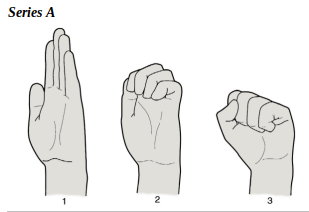
Step-by-step directions for Series B
• With your hand in front of you and your wrist straight, fully straighten all of your fingers (1)
• Make a “tabletop” with your fingers by bending at your bottom knuckle and keeping the fingers straight (2)
• Bend your fingers at the middle joint, touching your fin-gers to your palm (3)



